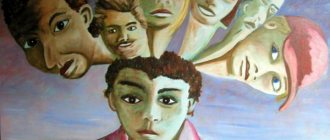Childhood
John Watson (1878–1958) was born in South Carolina, in the small town of Travelers Rest. His father, Pikens Watson, led a riotous lifestyle, which is why there were constant discords and scandals in the house. This led to the fact that 13 years after the birth of his son, his dad left the family. As a result, the boy was left with deep emotional trauma. His mother Emma was very religious by nature, which led to strict methods of raising the child, as well as an almost complete lack of freedom to choose further guidelines. And if John Watson had not lost his mother at the age of 22, it is quite possible that the world would not have heard of such an outstanding psychologist, since she passionately desired a career as a priest for her son.
Youth
After graduating from the Baptist school at Fermanagh University in 1900, he left his hometown and went to Chicago for his next education. John Watson enters the local philosophy department, but due to the specifics of teaching, he refuses his supervisor and turns his attention to psychology. Just 3 years later, he defended his doctoral dissertation on the topic of animal learning, for which he conducted numerous experiments on rats. In addition to the fact that he manages to become the youngest student in the history of the institution to receive an academic degree, he is also the first to devote such large-scale work to experiments on these particular rodents. This moment determined the directions of John's future activities and outlined the boundaries of future research.
John Brodes Watson
John Broadus Watson is an American scientist, psychologist, researcher of human behavior, founder of behaviorism (from the English behavior - behavior) - one of the most widespread theories in psychology of the 20th century. Watson did a lot to develop the psychology of advertising, so he is recognized as one of the creators of this area of applied research.John Watson was born in the small town of Travelers Rest in Southern California into a very religious family. In 1894 he entered the Southern Baptist School at Furman University, where he studied for five years; Among the subjects that interested him most was psychology [28]. In 1900, after a year of teaching school, he went to Chicago with $50 in his pocket, where he continued his education. Working as a janitor, waiter, and laboratory assistant, he, under the guidance of major specialists James Rowland Angell (1869–1949) and Henry Herbert Donaldson (1857–1938), brilliantly conducted research and in 1903 received a Doctor of Science degree.
His theoretical conclusions and experimental results became the basis of a new scientific direction in psychology, called “behaviorism.” In scientific publications and popular lectures and articles, Watson called behaviorism "the study of what people do." He was productive, published widely, edited two academic journals, and was elected president of the American Psychological Association in 1915. However, in 1920, personal circumstances - a high-profile divorce and marriage to his assistant - forced Watson, who by that time had been a professor and director of the psychological laboratory at Johns Hopkins University for more than ten years, to leave science. He entered the advertising industry as a well-known scientist at home and abroad, but he essentially had to start his career all over again.
Watson's transition from his familiar university environment to the world of advertising production and distribution shows how much intellectual potential was attracted to this then new applied field of psychology in the early 1920s: social researchers were already aware of the desire of advertising industry leaders to understand the mechanisms of advertising's influence on consciousness and behavior of consumers and their desire to use scientific recommendations in order to improve business efficiency. Moreover, even experienced and eminent scientists were seriously thinking about working in this research field. In any case, while still at the university, Watson spent a number of years thinking about expanding the use of his results and conclusions, and, among other directions, he considered cooperation with firms operating directly in the consumer market. In particular, he took steps to include the course “Psychology of Advertising” in the university curriculum [29, p. 207–220]. Watson was one of the founders and active participants of The Scott Company, a research and consulting agency in the field of applied psychology created on the initiative of Walter Scott.
In Watson's formulation [27 p. X] behaviorism was a branch of psychology whose primary goal was to predict and control human behavior. Moreover, Watson interpreted these functions of science quite literally. But it is one thing to understand the importance of applied psychology and contribute to its development while being in a familiar academic atmosphere, and quite another to leave the university and enter this new foreign world. In the fall of 1920, he was faced with a similar choice, and he made it. Watson had no doubt that he would find work in the business community, but he was not happy about it. Otherwise, he would not have written to his colleague, the famous psychiatrist Adolf Meyer (1866–1950), that it was still better than “raising chickens and cabbages.” But the letter ended with the words: “I will go into business completely, with an open heart and burn all bridges” [29, p. 211].
Watson decided to start his new career at the famous New York agency J. Walter Thompson" (JWT), headed by the then classic of this field Stanley Barnet Resor (Stanley Barnet Resor, 1879-1962), to whom he was introduced by his friend the sociologist and ethnographer William Isaac Thomas (1863-1947), in the 1930s made famous by his and Florian Znaniecki's (1882–1958) fundamental research into the lives of Polish peasants in America. Apparently the firm asked Watson to submit additional letters of recommendation from his colleagues. One of those who responded to this request was Edward Titchener, an American student of W. Wundt, one of the creators of structuralism and, what is important to note, a decisive, “orthodox” opponent of behaviorism and applied psychology [30].
This shows that Reasor and Watson shared the common idea that human behavior, particularly consumer behavior, is based on certain laws that can be discovered based on the concepts and methods of behaviorism. In other words, it seemed to them a natural and productive synthesis of the new psychological teaching and the “Thomsonian” (or “Rizorian”) culture of advertising. Reasor believed that Watson would lead and organize research that would discover the laws of human behavior and allow them to influence their consciousness. For his part, Watson wanted to “use his psychological knowledge and work skills to solve problems related to the market” [29, p. 212].
Despite Watson's scientific achievements and international reputation, he went through all the steps required by JWT's tenure policy, including providing guidance on his intellectual honesty and integrity. Like all new JWT employees, Watson mastered a special course - introduction to a new profession [4, p. 85]. First of all, he was asked to study the rubber footwear market over a large area. He recalled: “I was inexperienced and timid, but I soon learned to press the bell on the doors of houses and stop the cars of farmers to find out what brand of rubber shoes their family was wearing.”[31] For ten weeks he visited small shops, trying to sell there the type of coffee that the agency advertised, and then worked as a clerk in one of the department stores for two months. All this was part of the employee training program developed by Reesor. Watson wrote that his business experience showed his limited knowledge of psychology, a very superficial understanding of the advertising industry and ignorance of the habits and habitats of a widespread species of animals called consumers. His words are noteworthy: “... theoretically I have studied this species of animal throughout my entire life, but practically I don’t know how to approach it” [20].
But still, Watson’s work at the agency was not to study consumer psychology or the mechanisms of advertising influence, but to promote new ideas from psychology in marketing research. His lectures on behaviorism contributed to the development of the science of advertising and served as a bridge between existing theoretical constructs and future applied research in psychology.
Soon after joining JWT, Watson began to be seen as an ambassador for Reesor, who, as president of the world's largest advertising agency, was constantly in demand at high-level conferences. Watson, at Reesor's direction, represented the agency not only in American but also in international forums. He coped with this task perfectly. Watson was “an excellent speaker, a great presence, a good-looking man, and a public figure.”20
Watson devoted very little time or attention to the agency's routine research. He effectively became an apostle of Reesor's philosophy on the role of science in the advertising business. One historian of behaviorism noted: “Nobody said, 'Science! The science!" louder than Watson" [32]. In the early 1930s, Watson noted that psychology had already moved out of academic laboratories and into places where goods were bought and sold; market research is becoming an integral part of advertising campaigns, and advertising creators are opening their own laboratories to test consumer reactions [29, p. 214]. The science of advertising, according to Watson, was the psychology of trade, and the advertising process became scientific to the extent that it took into account the methods of psychology. In his lectures, he emphasized that “what advertising sells is more than a product”: it sells ideas, prestige, economics [29, p. 215].
Watson's newspaper articles and radio appearances were designed to offer products indirectly rather than directly. For example, he explained that coffee increases mental efficiency. He did not suggest buying Pebeco toothpaste, but he explained the functions of the salivary glands and related their work to the process of brushing teeth. Summaries of the lectures and paste samples were distributed to the lecture participants.
Watson's fame increased the credibility of his performances and helped the firm find new clients. In 1924 he became vice president of JWT.
A number of experts believe that Watson's direct contribution to the agency's activities was low. He truly failed to combine the principles of psychology and the practice of advertising. At JWT, advertising campaigns were planned and executed primarily by two eminent copywriters: Stanley Resor's wife, Helen Lansdown Resor (1886–1964), and James Young, whose style had long predated Watson's arrival at the agency. Young was vice president of JWT for many years, and he wrote down many of his observations and generalizations in a book of journal entries that included brief notes on the nature of knowledge about advertising and the knowledge of the nature of advertising. In one essay he wrote: “What can a person working in the field of personality psychology bring to advertising? The answer is not clear. Walter Dill Scott, I believe, made the first attempt more than twenty-five years ago in his "Psychology of Advertising"; success was modest. Later, the famous creator of behaviorism, John Watson, tried to make his contribution to advertising. But the advertising industry accepted John without accepting much of his psychology."33 And yet, one cannot fail to take into account that, as vice president of the agency, Watson successfully managed a number of multi-million dollar advertising projects commissioned by well-known companies, including: Baker's Chocolate, Coconut, Johnson and Johnson Baby Powder, Pebeco Toothpaste", "Odorono" and "Pond's Extract".
Watson's main contribution lies in the spread of applied science to advertising and other types of business. To do this, he used his lectures and actively published in the press. However, Watson not only demonstrated the capabilities of psychology in the study of advertising, he promoted behaviorism as a new direction of science. In 1924, the first edition of Watson's book Behaviorism [34] was published, containing a popular presentation of his scientific ideas. The book was published with a dedication to Rizor; Watson obviously had good reason to do so.
Rizor, of course, was well aware of the results of Gale, Scott and other psychologists who analyzed the mechanisms of perception of advertising in the first decades of the twentieth century. However, by inviting Watson to his agency, Reasor pursued a different, more general goal: his advertising philosophy required knowledge of the laws of human behavior. What the pioneers of the study of advertising did did not provide answers to his general theoretical questions; he needed a different, higher level of understanding the effectiveness of advertising. Apparently, Rizor could not help but understand the complexity of such a task and its long-term nature, and the first step towards solving it was seen by him in developing a general knowledge of advertising based on the principles and methods of science, in particular experimental and general psychology, economics and sociology. Therefore, he invited the highest class psychologist Watson to his agency, and a little later - economist and market researcher, Harvard professor Paul Cherington.
If we compare Watson’s activities with the goals that Reesor strove for, then we can agree with those experts who recognize his significant contribution to the development of the unique culture of advertising production at JWT. As for Watson’s role in the development of the science of advertising as a whole, the opinions of all experts are unanimous: Watson is rightfully one of the founders of this scientific direction [20].
Behaviorism
Two years after becoming a doctor of science, John Brodes Watson received an invitation to head the department of experimental psychology at the University of Baltimore. He willingly agrees, thereby opening up more and more opportunities for immersion in his own research and experiments. This period of his life is associated with the development of the concept thanks to which the name of the scientist entered the annals of history. He becomes the author and follower of the theory of behaviorism, which he describes in detail in his manifesto entitled "Psychology from the Behaviorist's Point of View." He read it publicly on February 24, 1913, a day that can rightfully be considered the birth of this movement. Watson declares to the world that psychology is rather an objective science belonging to the field of natural science. He criticizes its modern position and significance, saying that its study is mistakenly based on the inner world of a person, his thoughts and feelings. Whereas it would be correct to focus on external behavior, as well as data that can be confirmed experimentally.
Behaviorism in psychology
Behaviorism serves as the subject of studying the behavior of subjects. Human behavior is studied from the birth of an individual to the end of his life. The research is carried out from an objective point of view, which leads to ignorance of consciousness, sensations, will and imagination. Because of this view, behaviorists eliminated the concept of the subconscious and everything related to it.
The goal of behaviorism is to study the behavior of a subject in order to surpass it in the future and predict its response to certain events. Achieving such a goal is difficult, but realistic. Until now, such a practice could only take place through haphazardly used methods of social action.
Because there are multiple reactions, science is trying to change them. It turns out that the number of unconditional responses of the body at birth is not large. This denies the theory of instinct. Most of the instincts called by the old school of psychology are now classified as conditional. Behaviorists do not look for the genetic inheritance of behavioral responses or the inheritance of special abilities (for example, musical or artistic). They believe that every child is born with the same number of opportunities and, under certain external circumstances, they can be directed to study any narrow field.
An important detail of behaviorism is stimulus (S) - response (R). Animal psychologist Edward Lee Thorndike started from the theory of personality (a set of behavioral reactions) and discovered the law of effect. He pointed out that there is a connection between impulse and response, which is fueled by the stimulus.
The theory of behaviorism is that a person has skills and reflexes that he acquired in his environment. It turns out that the individual is an organized structure and an almost stable system of different skills.
Behaviorism in psychology considers personality as a subject that has reactions, functions and the ability to learn. It turns out that a person is programmed to reproduce different actions, behavior and reflexes.
Scientific career
Thanks to the novelty of the theory and its subsequent development, John Watson is at the pinnacle of greatness in scientific circles. His salary doubles, his research laboratory increases in size, and there is no end to students wanting to attend lectures. In 1915, he was appointed president of the American Psychological Association. These years can be called the heyday of behaviorism. The publications of the famous scientist appear every now and then in various publications, and 2 scientific journals are published under his editorship. In 1914, his bibliography was replenished with a very significant work, “Behavior: An Introduction to Comparative Psychology,” in which consciousness as a subject of psychology is completely rejected. His theories also gain practical application, and Watson himself masters the art of managing human behavior.
Achievements and awards
1915 - chaired the American Psychological Association (APA) 1919 - published Psychology as Behaviorists See It 1925 - published Behaviorism 1928 - published Psychological Care of Infants and Children 1957 - received the APA Award for Contributions to Psychology
Tags: biography, behaviorism
Have something to say? Leave a comment!:
- Next
- Prev
Personal life
While teaching at the university, the founder of behaviorism married his student Mary Ickes. Despite the fact that the couple had two children, their marriage could not be called successful. In 1920, the scientist’s next infatuation with a young graduate student destroyed not only his marriage, but also his entire successful career that he had been building for so many years. The wife discovered evidence of her husband's romantic correspondence and published it in the press, which caused a stormy scandal. From now on, there can be no talk of any teaching activity. The divorce was very loud, but despite this, Rosalia Rayner and John Watson, whose photo is presented below, immediately got married. And as a result of this marriage, which turned out to be more successful than the previous one, two more Watsons were born, both boys. Rosalia left this world early, 23 years before her husband. John took the loss hard, but still continued to work. True, in a slightly different direction.
During his student years, he managed to work as a laboratory assistant, a janitor and even a waiter, but in the future few people cared about this, because he became known to the world as John Watson, a psychologist. The cheating scandal forced him to look for new directions for implementation, and he chooses the practical sphere of application of the acquired knowledge. To be more specific, he immerses himself in advertising. At that time, this relatively new area required detailed research in order to find out the mechanisms for controlling consumer behavior. But it was this control that occupied a central position in the psychology of the industry, so John plunges headlong into an advertising career. He starts, like anyone else, from the very bottom, in one of the New York agencies under the management of Stanley Reasor. Together with other candidates, he goes through all stages of employment, even despite his extensive knowledge and scientific merits. Over time, he liberates himself, acquires new skills and is completely immersed in the psychology of trading, applying the provisions of his theories in practice. So, he manages to rise to the rank of vice president of the company and stay in this position for several years.
Watson's legacy
Working in the advertising industry, John Watson continues to put his scientific theories into books. After his death, several more works remain for future generations of psychologists and theorists, including “Behaviourism”, “Ways of Behaviorism” and “Psychological Care of the Child”. Among his most famous followers who worked further on the theory is Burres Skinner, who, together with other colleagues, managed to popularize behaviorism. However, the concept has repeatedly been subjected to severe criticism, mostly due to the fact that it more closely resembles a tool of coercion. In subsequent years, its study began to decline, leaving behind only a set of some techniques that are still used to this day in trade, politics and other areas.
Psychological experiment "Little Albert"
In his most famous and controversial experiment, known today as the Little Albert experiment, John Watson, along with an assistant named Rosalie Rayner, made a small child afraid of a white rat. They achieved this by repeatedly presenting white rats with a loud, frightening noise. They were also able to demonstrate that this fear could extend to other white and furry objects.
From an ethical point of view, the experiment is often criticized today: firstly, the child was never able to overcome this fear, and secondly, it turned out that Watson deliberately distorted the data of the experiment.
Last years of life and death
A few years after the death of his wife, a former teacher decides to leave the advertising business and settle on a quiet farm. There John Watson lives out his last days. The biography of his life ends in 1958. A few months earlier, the association of which he had once been president had included him in its list of honorary members. However, this did not help him forget the resentment that he was once deprived of his favorite job and the right to occupy certain positions, so in the same year in which he left this world, he starts a fire in the yard, giving away numerous scientific works to the flames. This becomes the last echo of any activity of Watson, but this act did not affect his reputation, because it was Watson’s contribution to psychology that made him one of the most outstanding scientists of the last century.








